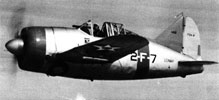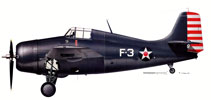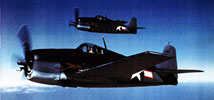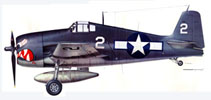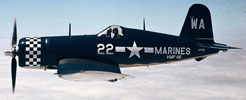- Flight Simulators
IL-2 Sturmovik 'Cliff's of Dover' Blitz - has no 3D model
IL-2 Sturmovik Battle of Stalingrad - has no 3D model
DCS World - has no 3D model
USN Top Fighter Pilot by Squadron and Leading Commanding Officer including Unit Total Kills Squadron # Nickname Start End A/C Carrier/Base Top Ace (kills w/ sqn) CO (kills w/ sqn) Kills # Aces VF-1 High Hatters Nov-43 Aug-44 F6F Yorktown CV-10 Richard Eastmond (9) B.M. Strean 100 3 VF-2 Rippers Mar-44 Sep-44 F6F Hornet CV-12 Cdr. William A. Dean (10) 240 28 VF-3 Felix the Cat Dec-41 May-42 F4F Lexington CV-2 Butch O'Hare (5) Jimmy Thach 18 1 May-42 Jun-42 F4F Yorktown CV-5 Elbert McCuskey (5) Jimmy Thach 34.5 1 VF-5 Aug-42 Oct-42 F4F Saratoga CV-3 H. M. Jensen (7) Leroy Simpler 78 4 Oct-43 Apr-44 F6F Yorktown CV-10 Robert Duncan (7) Ed Owens (5) 93.5 7 VF-6 Shooting Stars Dec-41 Oct-42 F4F Enterprise CV-6 Donald E. Runyon (8) James S. Gray 63 1 VF-6 Aug-43 Feb-44 F6F various CV's Alexander Vraciu (9) H.W. Harrison 37.5 0 VF-7 Sep-44 Jan-45 F6F Hancock CV-19 Lt. Cdr. L. J. Check (10) 72 2 VF-8 Dec-41 Jun-42 F4F Hornet CV-8 Merrill Cook (2) Sam Mitchell 5 0 Mar-44 Oct-44 F6F Bunker Hill CV-17 Cdr. William Collins (9) 156 13 VF-9 Cat o' Nines Oct-43 Mar-44 F6F Essex CV-9 Hamilton McWhorter (10) Phil Torrey 116 10 est. Mar-45 Jun-45 F6F Yorktown CV-10 Eugene Valencia (23) John S. Kitten 129 10 est. VF-10 Grim Reapers Oct-42 May-43 F4F Enterprise CV-6 Swede Vejtasa (7.25) J.H. Flatley 43 1 Jan-44 Jun-44 F6F Enterprise CV-6 Richard Devine (8) William Kane 88 5 Feb-45 Apr-45 F4U Intrepid CV-11 P. L. Kirkwood (8) Walter E. Clarke 87 7 VF-11 Sundowners May-43 Jul-43 F4F Guadalcanal Charles Stimpson (6) Charles White 52 2 Oct-44 Jan-45 F6F Hornet CV-12 Charles Stimpson (10) E. G. Fairfax 106 5 VF-12 Sep-43 Jun-44 F6F Saratoga CV-3 John Magda (4) R.G. Dose 20 0 Jan-45 Jun-45 F6F Randolph CV-15 Lt. Cdr. Frederick H. Michaelis (5) 51 2 VF-13 Black Cats Jul-44 Nov-44 F6F Franklin CV-13 Albert Pope (7) Wilson Coleman (6) 86 3 VF-14 Iron Angels May-44 Nov-44 F6F Wasp CV-18 William Knight (7.5) R. Gray 146 8 VF-15 Fighting Aces May-44 Nov-44 F6F Essex CV-9 McCampbell, Duncan, Rushing, Strane, Twelves James Rigg (11) 310 26 VF-16 Fighting Airedales Oct-43 Jun-44 F6F Lexington CV-16 Alexander Vraciu (10) Paul D. Buie (9) 136.5 7 VF-17 Jolly Rogers Oct-43 Mar-44 F4U Solomons Ike Kepford (16) Tom Blackburn (11) 152 11 VF-18 Oct-43 Mar-44 F6F Bunker Hill CV-17 Lt. Cdr. Sam Silber (6) 74 1 Aug-44 Nov-44 F6F Intrepid CV-11 Cecil Harris (22) Ed Murphy 176.5 13 VF-19 Satan's Kittens Jul-44 Nov-44 F6F Lexington CV-16 William Masoner Jr. (10) T. Hugh Winters (8) 155 11 VF-20 Aug-44 Jan-45 F6F Enterprise CV-6/etc. Douglas Baker (16.33) Fred Bakutis (7.5) 158 9 VF-21 Feb-43 Jul-43 F4F Guadalcanal Ross Torkelson (6) John Hulme 69 3 Jul-44 Oct-44 F6F Belleau Wood CVL-24 Bob Thomas (5) V. F. Casey 40 1 VF-22 Sep-44 Jan-45 F6F Cowpens CVL-25 Clement Craig (12) Thomas Jenkins 49.5 3 VF-23 Aug-43 May-44 F6F Princeton CVL-23 L.H. Kerr (4.83) H.L. Miller 35 0 VF-26 Apr-44 Oct-44 FM2 Santee CVE-29 Kenneth Hippe (6) Harold Funk 31 1 VC-27 Oct-44 Jan-45 FM2 Savo Island Ralph Elliott (9) P. W. Jackson 61 1 VF-27 May-44 Oct-44 F6F Princeton CVL-23 James Shirley (12) Fred Bardshar (7.5) 134 10 VF-28 May-44 Dec-44 F6F Monterey CVL-26 Oscar Bailey (5) Roger Mehle 55 2 VF-29 Oct-44 Apr-45 F6F Cabot CVL-28 Robert Murray (10.3) William Eder (6.5) 113 12 VF-30 Jan-45 Jun-45 F6F Belleau Wood CVL-24 James Reber (11) Douglas A. Clark 110 7 VF-31 Meat Axers Jan-44 Sep-44 F6F Cabot CVL-28 Cornelius Nooy (19) Bob Winston 165.5 14 VF-32 Outlaw's Bandits Mar-44 Oct-44 F6F Langley CVL-27 Lt. Cdr. Eddie Outlaw (6) 44 2 VF-33 Aug-43 Jan-44 F6F Solomons Frank Schneider (7) Hawley Russell 74.5 3 VF(N)-41 Aug-44 Jan-45 F6F Independence CVL-23 William Henry (9.5) T. F. Caldwell 46 2 VF-42 Dec-41 May-42 F4F Yorktown CV-5 Art Brassfield (4.83) Oscar Pedersen 25 0 VF-44 Crusaders Oct-44 Feb-45 F6F Langley CVL-27 Cdr. Malcolm T. Wordell (7) 47 3 VF-45 Nov-44 May-45 F6F San Jacinto CVL-30 James B. Cain (8) Gordon Schechter 81.5 6 VF-47 Fighting Cocks Mar-45 Aug-45 F6F Bataan CVL-29 Samuel Hibbard (7.33) Albert Clancy 67.5 1 VF-50 Devil Cats Apr-44 Jul-44 F6F Bataan CVL-29 Daniel Rehm (6) J.C. Strange 61 4 VF-51 Apr-44 Nov-44 F6F San Jacinto CVL-30 William Maxwell (7) C. L. Moore 50.5 1 VF-60 Nov-43 Oct-44 F6F Suwanee CVE-27 R. Singleton (3.25) H.O. Feilbach 25 0 VF-72 Jul-42 Oct-42 F4F Hornet CV-8 George Wrenn (5.25) Henry Sanchez 38 1 VF-80 Vorse's Vipers Nov-44 Jan-45 F6F Ticonderoga CV-14 Patrick Fleming (19) Leroy Keith 159.5 10 VF-82 Jan-45 Jun-45 F6F Bennington CV-20 Robert Jennings (7) Edward Hassell 85 5 VF-83 Kangaroos Mar-45 Sep-45 F6F Essex CV-9 Thaddeus Coleman (8) H.A. Sampson 137 11 VBF-83 Mar-45 Sep-45 F4U Essex CV-9 Thomas Reidy (10) Frank Patriarca 91 3 VF-84 Wolf Gang Jan-45 Jun-45 F4U Bunker Hill CV-17 Doris Freeman (7) Roger R. Hedrick 137 4
Naval Base Kitsap Bremerton, Washington Map
USS Langley (CVL-27) citations notes:
USS Langley (CVL-27) citations:
- Hickerson, Loren (1986). 'The Langley Legacy'. Proceedings. Supplement (April). United States Naval Institute: 65–74.
- 'Porte-avions La Fayette'. www.netmarine.net.
Bibliography:
- Anderson, Richard M. & Baker, Arthur D. III (1977). 'CV-2 Lex and CV-3 Sara'. Warship International. XIV (4): 291–328. ISSN 0043-0374.
- Berhow, Mark A., ed. (2004). American Seacoast Defenses, A Reference Guide (Second ed.). CDSG Press. ISBN 0-9748167-0-1.
- Brown, J. D. (2009). Carrier Operations in World War II. Annapolis, Maryland: Naval Institute Press. ISBN 978-1-59114-108-2.
- Friedman, Norman (1983). U.S. Aircraft Carriers: An Illustrated Design History. Annapolis, Maryland: Naval Institute Press. ISBN 0-87021-739-9.
- Friedman, Norman (1984). U.S. Cruisers: An Illustrated Design History. Annapolis, Maryland: Naval Institute Press. ISBN 0-87021-718-6.
- Fry, John (1996). USS Saratoga CV-3: An Illustrated History of the Legendary Aircraft Carrier 1927–1946. Atglen, Pennsylvania: Schiffer Publishing. ISBN 0-7643-0089-X.
- Lundstrom, John B. (2005). The First Team: Pacific Naval Air Combat from Pearl Harbor to Midway. Annapolis, Maryland: Naval Institute Press. ISBN 1-59114-471-X.
- Lundstrom, John B. (1994). The First Team and the Guadalcanal Campaign. Annapolis, Maryland: Naval Institute Press. ISBN 1-55750-526-8.
- Nofi, Albert A. (2010). To Train the Fleet for War: The U.S. Navy Fleet Problems. Naval War College Historical Monograph. Vol. 18. Newport, Rhode Island: Naval War College Press. ISBN 978-1-884733-69-7.
- Polmar, Norman; Genda, Minoru (2006). Aircraft Carriers: A History of Carrier Aviation and Its Influence on World Events. Vol. 1, 1909–1945. Washington, D.C.: Potomac Books. ISBN 1-57488-663-0.
- Rohwer, Jürgen (2005). Chronology of the War at Sea 1939–1945: The Naval History of World War Two (Third Revised ed.). Annapolis, Maryland: Naval Institute Press. ISBN 1-59114-119-2.
- 'Saratoga V'. Dictionary of American Naval Fighting Ships. Naval History & Heritage Command (NH&HC).
- Stahura, Barbara (2003). U.S. S. Saratoga: CV-3 & CVA/CV-60 (Revised ed.). Paducah, Kentucky: Turner Publishing. ISBN 1-56311-855-6.
- Stern, Robert C. (1993). The Lexington Class Carriers. Annapolis, Maryland: Naval Institute Press. ISBN 1-55750-503-9.
- Stille, Mark (2005). US Navy Aircraft Carriers 1922–1945: Prewar Classes. New Vanguard. Vol. 114. Oxford, UK: Osprey Publishing. ISBN 1-84176-890-1.
- Tully, Anthony P.; Casse, Gilbert (March 2012). 'IJN Ryujo: Tabular Record of Movement'. Combinedfleet.
- Wadle, Ryan David (August 2005). United States Navy Fleet Problems and the Development of Carrier Aviation, 1929–1933 (PDF). College Station, Texas: Texas A & M University.
Magazine References: +
- Airfix Magazines (English) - http://www.airfix.com/
- Avions (French) - http://www.aerostories.org/~aerobiblio/rubrique10.html
- FlyPast (English) - http://www.flypast.com/
- Flugzeug Publikations GmbH (German) - http://vdmedien.com/flugzeug-publikations-gmbh-hersteller_verlag-vdm-heinz-nickel-33.html
- Flugzeug Classic (German) - http://www.flugzeugclassic.de/
- Klassiker (German) - http://shop.flugrevue.de/abo/klassiker-der-luftfahrt
- Le Fana de L'Aviation (French) - http://boutique.editions-lariviere.fr/site/abonnement-le-fana-de-l-aviation-626-4-6.html
- Le Fana de L'Aviation (French) - http://www.pdfmagazines.org/tags/Le+Fana+De+L+Aviation/
- Osprey (English) - http://www.ospreypublishing.com/
- Revi Magazines (Czech) - http://www.revi.cz/
Web References: +
- Wikipedia - https://en.wikipedia.org/wiki/USS_Langley_(CVL-27)
- Naval History and Heritage Command - https://www.history.navy.mil/research/histories/ship-histories/danfs/l/langley-cvl-27-ii.html
- Wikipedia - https://en.wikipedia.org/wiki/Isoroku_Yamamoto


-off-Nansei-Shoto-10th-October-1944-80-G-284074.jpg)
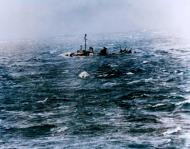
 in Indo-China waters 1953 NH 79384.jpg)
-near-Nansei-Shoto-off-China-coast-10th-Oct-1944-80-G-284083.jpg)
-near-Nansei-Shoto-off-China-coast-10th-Oct-1944-80-G-284085.jpg)
-near-Nansei-Shoto-off-China-coast-10th-Oct-1944-80-G-284082.jpg)
-planes-in-Masbate-Harbor-Philippines-Sep-1944-80-G-281083.jpg)
-viewed-from-USS-Lexington-(CV-16)-on-24th-Oct-1944-80-G-284377.jpg)
-leading-entering-Ulithi-anchorage-12th-Dec-1944-80-G-301351.jpg)
-anchored-in-Ulithi-harbor-Caroline-Islands-on-31st-Oct-1944-80-G-258424.jpg)
-at-anchor-in-harbor-Feb-1944-80-G-321677.jpg)
-bombing-strike-on-Engebi-Island-Eniwetok-Atoll-Marshall-Islands-27th-Feb-1944-80-G-221248.jpg)
-bombing-strike-on-Engebi-Island-Eniwetok-Atoll-Marshall-Islands-27th-Feb-1944-80-G-221255.jpg)
-flight-deck-after-being-hit-by-a-Kamikaze-off-Formosa-21st-Jan-1945-80-G-273422.jpg)
-flight-deck-under-repair-after-being-hit-by-a-Kamikaze-off-Formosa-21st-Jan-1945-80-G-273441.jpg)
-in-heavy-seas-during-operations-against-the-Japanese-TF38.3-Philippines-Dec-1944-80-G-301359.jpg)
-pitching-enroute-to-press-attacks-on-Japanese-homeland-with-CLs-beyond-18th-March-1945-80-G-313864.jpg)
-refueling-at-sea-during-Philippines-campaign-13th-Nov-1944-80-G-270704.jpg)
-rolling-sharply-as-she-rides-out-Typhoon-Cobra-from-USS-Essex-(CV-9)-13th-Jan-1945-80-G-305484.jpg)
-rolling-sharply-as-she-rides-out-Typhoon-Cobra-from-USS-Essex-(CV-9)-13th-Jan-1945-NH-89374.jpg)
-Task-Group-38.3-makes-a-simultaneous-turn-to-port-entering-Ulithi-anchorage-12th-Dec-1944-80-G-301354.jpg)
-TBF-1C-Avengers-of-VT-32-formation-with-White-5-training-sortie-over-Oahu-Hawaii-16th-Jan-1944-80-G-219190.jpg)
-underway-off-Cape-Henry-Virginia-with-two-SNJ-training-planes-6th-Oct-1943-80-G-87113.jpg)
-underway-with-a-task-force-in-the-Pacific-27th-Mar-1945-80-G-312491.jpg)
-with-a-task-force-as-seen-from-USS-McCord-(DD-534)-)80-G-312493.jpg)
-as-she-rides-out-Typhoon-Cobra-seen-from-USS-Brush-(DD-745)-13th-Jan-1945-NH-89376.jpg)
-Task-Group-38.3-makes-a-simultaneous-turn-to-port-entering-Ulithi-anchorage-12th-Dec-1944-80-G-301354.jpg)
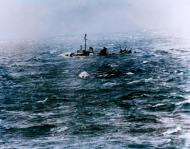
-off-the-Mare-Island-Navy-Yard-California-20th-April-1942-19-N-29840.jpg)
-at-the-Mare-Island-Navy-Yard-California-29th-May-1942-19-N-30484.jpg)
-preparing-to-refuel-at-sea-8th-Jan-1943-80-G-38034.jpg)
-at-Mare-Island-Navy-Yard-17th-Feb-1942-19-N-28346.jpg)
-at-sea-May-1944-80-G-376093.jpg)
-underway-at-sea-28th-April-1938-80-G-425603.jpg)
-steaming-in-Iron-Bottom-Sound-off-Guadalcanal-viewed-by-USS-Montpelier-(CL-57)-23rd-Mar-1944-80-G-48564.jpg)
-coming-into-Ulithi-Anchorage-during-a-break-in-operations-on-24th-Nov-1944-NH-58573.jpg)
-underway-at-15-knots-off-Point-Wilson-Washington-on-11th-July-1944-NH-97255.jpg)
 in Indo-China waters 1953 NH 79384.jpg)
